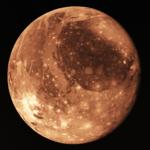


The Moon
the Moon was probably made 4.5 billion years ago when a large object hit the Earth and blasted out rocks that came together to orbit round the Earth...

IO
Jupiter is the largest planet in the Solar System and has at least 16 large moons and even more very small ones. Four of Jupiter’s...

Europa
The planet Jupiter is the largest planet in the Solar System and has a huge number of moons that orbit around it...

Callisto
Jupiter is the giant of the Solar System and has something like 50 or more satellites. A satellite is something that orbits around a body in space...

Ganymede
Ganymede is one of the many satellites, or moons, that orbit round the great planet, Jupiter. None of these moons can be seen with the naked eye but the four...

Phobos
Mars has two moons. The first of these moons is Phobos, named for a character in the legendary piece of Greek literature, The Iliad...

Deimos
Deimos ( Dee-Mos) is the second of two moons orbiting Mars. It is considered the second moon because it is much farther away from Mars than the first moon, Phobos...


natural satellites
A natural satellite is a not man-made object that orbits a planet or other body larger than itself. It is often called moons to identify non-artificial satellites of planets, dwarf planets, or minor planets. There are 240 known moons within the solar system, including 163 orbiting the planets, four orbiting dwarf planets, and dozens more orbiting small solar system bodies.
Planets like Mercury and Venus have no moon at all; Earth has one large moon (the Moon); and Mars has two tiny moons: Phobos and Deimos. Among the dwarf planets, Ceres has no moons (though many objects in the asteroid belt do), Eris has one: Dysnomia, and Pluto has three known satellites: Nix, Hydra, and a large companion called Charon. The Pluto-Charon system is unusual in that the center of mass lies in open space between the two, a characteristic of a double planet system.
